

Seawildearth. Craig Venter - The Incredible Biodiversity of the Oceans. On estimating the number of species from the discovery record. Systems ecology: Biology on the high seas. Image Slideshow Eric Karsenti spent a total of three months aboard Tara during her 938-day plankton-sampling expedition.Julien Girardot/Tara Oceans The scientists used various tools to collect plankton — free-floating ocean organisms that are crucial for cycling chemicals and nutrients for the planet.S.Bollet/Tara Expeditions Plankton includes diatoms, which are responsible for about one-fifth of the breathable oxygen on Earth.C.Sardet/CNRS/Tara Oceans Copepods account for vast quantities of Earth’s biomass and are a staple food for fish and other sea life.Noan LeBescot/CNRS/Tara Oceans Plankton also includes the larvae of fish, crustaceans, molluscs and more.C.Guiguand/Tara Oceans Phronima, insect-like zooplankton, can often be found inhabiting the carcases of other creaturesLuis Gutierrez Herredia/UCD/Tara Oceans.

PLOS Collections : Article collections published by the Public Library of Science. How Many Species Are There on Earth and in the Ocean? Abstract The diversity of life is one of the most striking aspects of our planet; hence knowing how many species inhabit Earth is among the most fundamental questions in science.
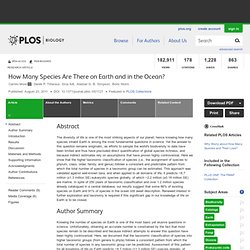
Yet the answer to this question remains enigmatic, as efforts to sample the world's biodiversity to date have been limited and thus have precluded direct quantification of global species richness, and because indirect estimates rely on assumptions that have proven highly controversial. Microscopic, Biochemical, and Molecular Characteristics of the Chilean Blob and a Comparison With the Remains of Other Sea Monsters: Nothing but Whales.
Marine cycles in flux : Nature Geoscience. Www.plosone.org/article/fetchObject.action?uri=info%3Adoi%2F10.1371%2Fjournal.pone.0011683&representation=PDF. Microbial Ecology of the Dark Ocean above, at, and below the Seafloor. Opinion: Exploring a Little-Known Planet. Animal Families With The Most Diversity Also Have Widest Range Of Size. Somewhere out there in the ocean, SpongeBob SquarePants has a teeny-tiny cousin and a humongous uncle.
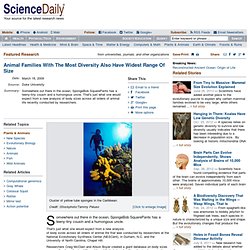
That's just what one would expect from a new analysis of body sizes across all orders of animal life that was conducted by researchers at the National Evolutionary Synthesis Center (NESCent), in Durham, N.C. and the University of North Carolina, Chapel Hill. Researchers Craig McClain and Alison Boyer created a giant database on body sizes across all orders of animal life and found that phyla -- families of animals grouped together by a similar body plan -- with the greatest diversity of species were also those with the largest range of body sizes. Noc.ac.uk/f/content/downloads/2013/The Discovery Collections leaflet.pdf. World's deepest sea vents reveal unknown creatures - in pictures. In pictures: Ocean expeditions. A Deep-Sea Bestiary. An amazing image of the elusive big-fin squid. By Dr. M, on November 17th, 2013 Abyss, Biology, Cephalopods, Ecology, Habitats, Organisms Big Fin Squid, Magnapinna, ROV.
A New Map of Ocean Life — Census of Marine Life Maps and Visualization. Image Gallery. About the Census. A DECADE OF DISCOVERY 2,700 scientists 80+ nations 540 expeditions US$ 650 million 2,600+ scientific publications 6,000+ potential new species 30 million distribution records and counting These numbers only begin to describe the scope of the Census of Marine Life, a 10-year international effort undertaken in to assess the diversity (how many different kinds), distribution (where they live), and abundance (how many) of marine life—a task never before attempted on this scale.
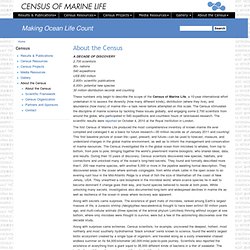
The Census stimulated the discipline of marine science by tackling these issues globally, and engaging some 2,700 scientists from around the globe, who participated in 540 expeditions and countless hours of land-based research. The scientific results were reported on October 4, 2010 at the Royal Institution in London. Along with secrets came surprises. Along with surprises came extremes. Craig Venter - The Incredible Biodiversity of the Oceans. Www.southampton.ac.uk/~jtc/Lebbeus_virentova.pdf.
Www.southampton.ac.uk/~jtc/Rimicaris_hybisae.pdf. Ophiactis tyleri. Bobmarleya gadensis. General Description This is a large, rather dark frenulate, living in a soft ringed tube about 2 mm in diameter.The tube is white, semi-transparent on the first 5 to 10 mm, but it becomes dark brown in the middle and then lighter again to reach a white/greyish colour at the posterior end.

Vulcanolepas scotiaensis sp. nov., a new deep-sea scalpelliform barnacle (Eolepadidae: Neolepadinae) from hydrothermal vents in the Scotia Sea, Antarctica. Marine Bivalve Shells of the British Isles. NMW Image No.
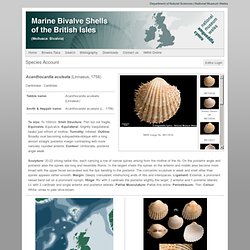
M010639 Acanthocardia aculeata (Linnaeus, 1758) Cardioidea : Cardiidae To size: To 100mm. Shell Structure: Thin but not fragile. Sculpture: 20-22 strong radial ribs, each carrying a row of narrow spines arising from the midline of the rib. Distribution Plate 1 Plate 2 Plate 3 Plate 4 Plate 5 Plate 1 Plate 2 Plate 3 Plate 4 Plate 5 Distribution & Ecology A southern species ranging into British waters only in the western English Channel. NBN records outside of this area are likely to be erroneous Depth RangeContinental Shelf (to 200m) Collector's curve of Deep Sea Vent species. Welcome to CenSeam: a Global Census of Marine Life on Seamounts. Mariana Trench: Deepest ocean 'teems with microbes' 18 March 2013Last updated at 01:39 GMT By Rebecca Morelle Science reporter, BBC World Service The deepest place in the ocean is teeming with microscopic life, a study suggests.
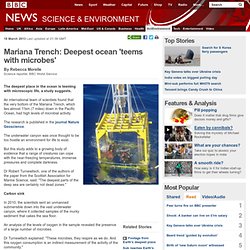
An international team of scientists found that the very bottom of the Mariana Trench, which lies almost 11km (7 miles) down in the Pacific Ocean, had high levels of microbial activity. Do Deep-Sea Fish Explode When They Are Brought to the Surface? No.
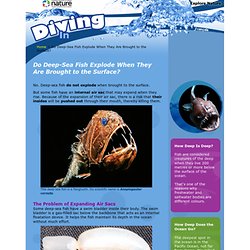
Deep-sea fish do not explode when brought to the surface. But some fish have an internal air sac that may expand when they rise. Because of the expansion of their air sac, there is a risk that their insides will be pushed out through their mouth, thereby killing them.